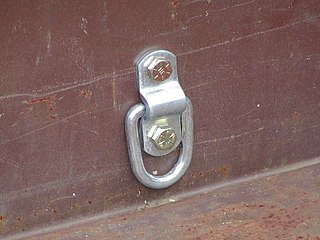Bondage, in the BDSM subculture, is the practice of consensually tying, binding, or restraining a partner for erotic, aesthetic, or somatosensory stimulation. A partner may be physically restrained in a variety of ways, including the use of rope, cuffs, bondage tape, or self-adhering bandage.

Fetish fashion is any style or appearance in the form of a type of clothing or accessory, created to be extreme, revealing, skimpy, or provocative in a fetishistic manner. By definition, most people do not wear these styles; if everyone wears an item, it cannot have a fetishistic, special nature. They are usually made of materials such as leather, latex or synthetic rubber or plastic, nylon, PVC, spandex, fishnet, and stainless steel. Some fetish fashion items include: stiletto heel shoes and boots, hobble skirts, corsets, collars, full-body latex catsuits, stockings, miniskirt, crotchless underwear, jockstraps, diapers, garters, locks, rings, zippers, eyewear, handcuffs, and stylized costumes based on more traditional outfits, such as wedding dresses that are almost completely see-through lace, or lingerie for men.

Handcuffs are restraint devices designed to secure an individual's wrists in proximity to each other. They comprise two parts, linked together by a chain, a hinge, or rigid bar. Each cuff has a rotating arm which engages with a ratchet that prevents it from being opened once closed around a person's wrist. Without a key, handcuffs cannot be removed without specialist knowledge, and a handcuffed person cannot move their wrists more than a few centimetres or inches apart, making many tasks difficult or impossible.

A belt is a flexible band or strap, typically made of leather, plastic, or heavy cloth, worn around the natural waist or near it. The ends of a belt are free; and a buckle forms the belt into a loop by securing one end to another part of the belt, at or near the other end. Often, the resulting loop is smaller than the hips. Belts come in many lengths because of the variety in waist sizes, and most belts can be adjusted at the buckle to suit the wearer's waist.

Bondage cuffs are restraints designed for use in sexual bondage situations. Compared to conventional handcuffs, they are wide wrist and ankle restraints generally made of leather, often padded with soft leather or fake fur. Bondage cuffs may be fastened at the wrists and/or ankles by a locking mechanism, by a buckle or by velcro. They are secured around the wrist or ankle, and the cuffs may then be attached to each other or another object.

Bondage in BDSM is the activity of tying or restraining people using equipment such as chains, cuffs, or collars for mutual erotic pleasure. According to the Kinsey Institute, 12% of females and 22% of males respond erotically to BDSM.

A gag is a device used in sexual bondage and BDSM roleplay. Gags are usually associated with roleplays involving bondage, but that is not necessarily the case. The person who wears the gag is regarded as the submissive partner, while the other is regarded as the dominant one. People may wear gags for a variety of reasons. Some people derive erotic pleasure from a gag, either in a submissive or dominant role. When combined with other physical restraints, the wearing of a gag can increase the wearer's sense of helplessness and anxiety level within a BDSM scene by rendering them unable to speak during sexual activity, which some people enjoy.

A D-ring is an item of hardware, usually a tie-down metal ring shaped like a capital letter 'D' used primarily as a lashing or attachment point. The term is found interchangeably spelled in different forms, such as: D ring, D-ring or dee-ring.

A waist bag, fanny pack, belt bag, moon bag, belly bag, or bumbag is a small fabric pouch worn like a belt around the waist by use of a strap above the hips that is secured usually with some sort of buckle. The straps sometimes have tri-glide slides, making them adjustable in order to fit properly. It can be considered as a purse worn around the waist.

A bondage harness is a piece of BDSM equipment worn for the purposes of bondage. The harness typically consists of a series of leather straps, usually between 1 and 2 cm wide, attached together in such a way as to allow a person to "wear" the item. Customization of the harness may be needed depending on the specific individual's body.

A safety harness is a form of protective equipment designed to safeguard the user from injury or death from falling. The core item of a fall arrest system, the harness is usually fabricated from rope, braided wire cable, or synthetic webbing. It is attached securely to a stationary object directly by a locking device or indirectly via a rope, cable, or webbing and one or more locking devices. Some safety harnesses are used in combination with a shock-absorbing lanyard, which is used to regulate deceleration and thereby prevent a serious G-force injury when the end of the rope is reached.

A chain is a serial assembly of connected pieces, called links, typically made of metal, with an overall character similar to that of a rope in that it is flexible and curved in compression but linear, rigid, and load-bearing in tension. A chain may consist of two or more links. Chains can be classified by their design, which can be dictated by their use:
A neck corset is a type of BDSM collar. Unlike a normal corset which compresses the waist, a neck corset is usually not used to compress the neck, except in breathplay. It may act as a posture collar that incorporates stays.

Prisoner transport is the transportation of prisoners from one secure location to another. It may be carried out by law enforcement agencies or private contractors such as Prisoner Transportation Services.

A police duty belt is a belt, typically constructed of nylon or leather used by police, prison and security officers to carry equipment easily in a series of pouches attached to the belt, in a readily-accessible manner, while leaving the hands free to interact. This belt can carry any number of useful items, ranging from handcuffs to guns.

Anglo-Saxon dress refers to the clothing and accessories worn by the Anglo-Saxons from the middle of the fifth century to the eleventh century. Archaeological finds in Anglo-Saxon cemeteries have provided the best source of information on Anglo-Saxon costume. It is possible to reconstruct Anglo-Saxon dress using archaeological evidence combined with Anglo-Saxon and European art, writing and literature of the period. Archaeological finds have both supported and contradicted the characteristic Anglo-Saxon costume as illustrated and described by these contemporary sources.
A belly chain is a physical restraint worn by prisoners, consisting of a chain around the waist, to which the prisoner's hands may be chained or cuffed. Sometimes the ankles are also connected by means of longer chains.

An armbinder or monoglove is a type of restraint device primarily used in bondage play, designed to bind the arms and/or hands to each other or to the body, usually behind the back, and employing a range of bondage equipment including cuffs, rods, straps, and gloves.
The Medieval period in England is usually classified as the time between the fall of the Roman Empire to the beginning of the Renaissance, roughly the years AD 410–1485. For various peoples living in England, the Anglo-Saxons, Anglo-Danes, Normans and Britons, clothing in the medieval era differed widely for men and women as well as for different classes in the social hierarchy. The general styles of Early medieval European dress were shared in England. In the later part of the period, men's clothing changed much more rapidly than women's styles. Clothes were very expensive, and both men and women were divided into social classes by regulating the colors and styles that various ranks were permitted to wear. In the early Middle Ages, clothing was typically simple and, particularly in the case of lower-class peoples, served only basic utilitarian functions such as modesty and protection from the elements. As time went on the advent of more advanced textile techniques and increased international relations, clothing gradually got more and more intricate and elegant, even with those under the wealthy classes, up into the renaissance.

A human pony harness is used for bondage: for restraint, decoration, or to facilitate work such as pulling a cart. It is usually made of leather but can be rope, biothane or other appropriate material. It is wrapped around the wearer's body in such a way that it cannot be slipped off. The wearer may have his/her hands strapped behind his/her back, although this is not usually recommended for pulling a cart or other work, in case of a fall. D-rings can be attached, so ropes or chains can be put on to lead the person around.

















